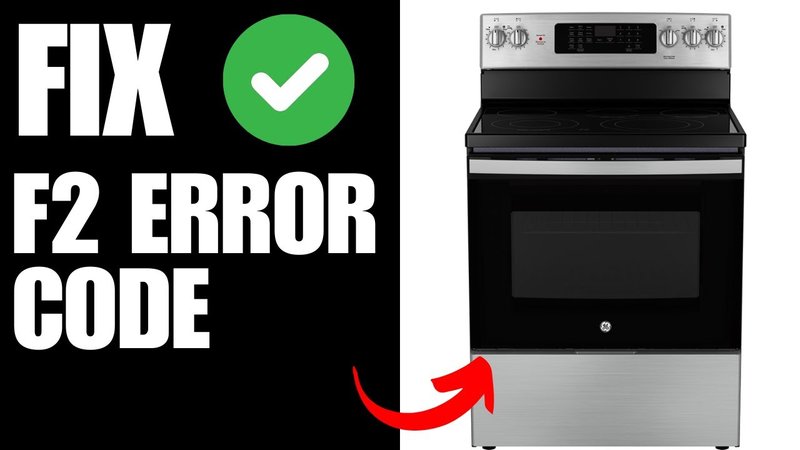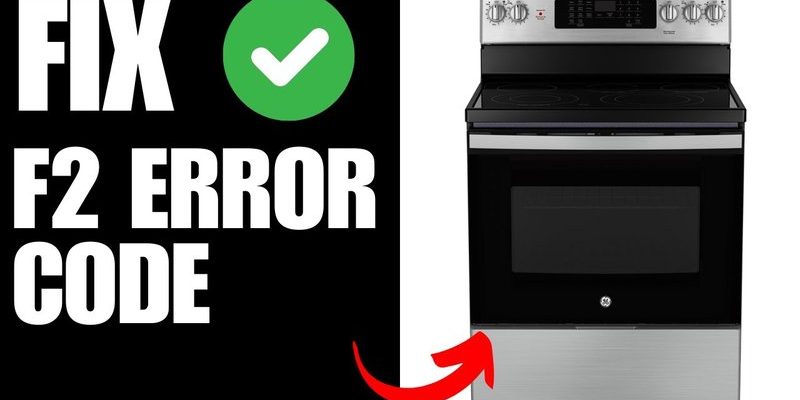
Error codes on appliances like GE ovens and ranges are essentially their way of saying, “Hey, something’s not right!” It’s akin to when your car’s check engine light comes on. Just as that light suggests there’s an issue under the hood, error code F2 is your oven’s way of indicating a specific problem. In most cases, this code points to an issue with the oven temperature sensor or the control panel. Let’s delve into what you should do when you see this code and when it’s time to call in a professional.
What Does Error Code F2 Mean?
You might be wondering, “What exactly is going wrong when my oven shows an F2 error code?” Well, here’s the deal: this code typically signifies that the oven is detecting a runaway temperature condition. Imagine your oven as a mini climate-controlled environment; it’s designed to keep temperatures steady, just like a thermostat does for your house. When this system gets out of whack, the F2 code lights up the display.
In most GE ovens and ranges, the F2 code is usually triggered by a malfunctioning oven temperature sensor. Think of this sensor as your oven’s thermometer, responsible for ensuring it maintains the correct heat. If it starts providing incorrect readings, your oven might heat up too much or not enough, resulting in that flashing F2 warning. Alternatively, the control board, which acts like the oven’s brain, might not be receiving or sending signals properly, leading to similar issues.
While this may sound complex, understanding the basic function of these components can help you grasp why the F2 code appears. Knowing if the issue is sensor-related or if there’s a deeper problem with the control board helps determine whether a DIY fix is feasible or if you need a technician’s expert touch.
Should You Try Fixing It Yourself?
Alright, so you’ve identified the F2 code and have a basic understanding of what might be causing it. The next question is, should you take a stab at fixing it yourself? This task is a bit like deciding whether to unclog a drain or call a plumber. For some, DIY is the thrill of the challenge, while others prefer the peace of mind that comes from professional help.
Firstly, if you’re comfortable with basic tools and have a knack for DIY projects, you might start by checking the oven sensor. The sensor is usually located inside the oven; it resembles a small metal rod at the back. Ensure the oven is powered off, and then you can test the sensor’s resistance using a multimeter. Resistance is measured in ohms, and a typical reading should be around 1100 ohms at room temperature. If the reading is off, replacing the sensor might solve the problem.
However, if you’re unsure or uneasy about dabbling with electrical components, it’s always wise to err on the side of caution. Messing with electrical wiring can be dangerous, and sometimes, a seemingly small fix can lead to larger problems if not handled correctly. In such cases, reaching out to a technician can be the best course of action to avoid risks or further damage to your oven.
When To Call a Professional Technician
So, when should you actually pick up the phone and call a technician? Let’s say you’ve checked the oven sensor, and everything seems fine, or perhaps you’re not willing to go it alone. That’s totally okay! Recognizing when a problem is beyond a DIY fix is a crucial part of home maintenance.
If the oven’s control board is suspected to be the culprit, this typically signals a need for professional intervention. The control board manages multiple functions within your oven, and replacing or repairing it involves intricate work that is best handled by someone with training and experience. Consider technicians as the “surgeons” for your oven; they have the tools, the know-how, and the experience to navigate complex issues safely and efficiently.
Additionally, if the cost of potential DIY errors outweighs the cost of hiring a pro, that’s another clear sign it’s time to call in reinforcements. A qualified technician will not only solve the F2 error but also check for any other underlying issues that could cause future problems, giving you peace of mind and a fully functional oven once more.
Preventative Measures and Managing Future Errors
Now that you’re armed with knowledge about error code F2, you’re in a better position to deal with it — or ideally, prevent it altogether. Just like regular oil changes can keep your car running smoothly, a little maintenance can go a long way for your oven.
To minimize the risk of future issues, make it a habit to keep your oven clean and inspect it regularly. By cleaning away grease and debris, you ensure that the oven’s components are less likely to malfunction due to buildup and blockages. It’s also wise to occasionally check that your oven’s door seals are intact and not allowing heat to escape, which helps maintain accurate temperature readings.
In case new error codes pop up, take them as early warnings. Just like the F2 code, other error messages are signals from your oven that something needs a look-see. Addressing these signals promptly can prevent small glitches from turning into major headaches.
In conclusion, understanding when to call a technician for your GE oven or range’s F2 error is as much about recognizing your limits as it is about knowing your appliance. Use this knowledge to keep your kitchen running smoothly and your cooking stress-free!
